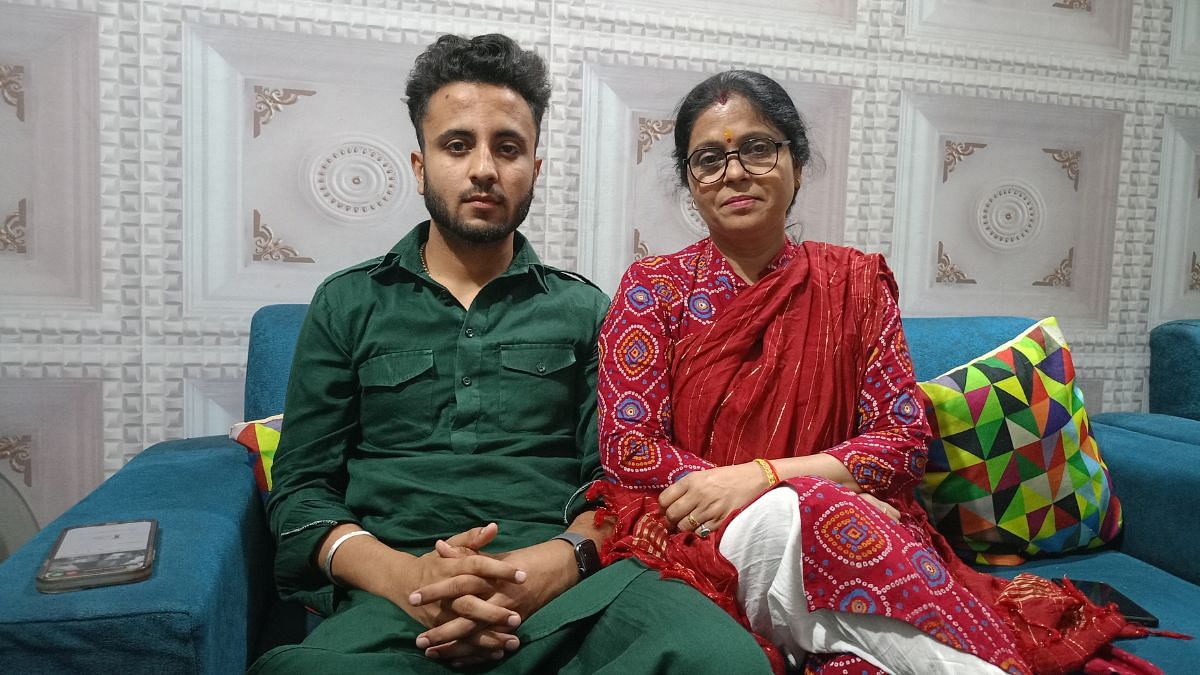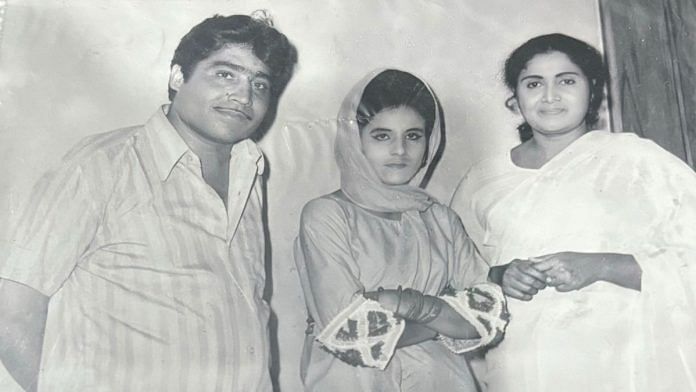Dugri: In Imtiaz Ali’s Amar Singh Chamkila, Punjabi singer Surinder Sonia gets barely eight to 10 minutes of screen time, appearing in three blink-and-miss scenes and a song. This doesn’t do justice to the person who ensured that the legacy of “Elvis of Punjab”, who was gunned down on 8 March 1988 in Mehsampur village, lived on.
For 15 years, until she died of illness, Sonia made sure that the annual festival commemorating Chamkila was a success. She would meet with the village sarpanch, collect funds, and invite singers and performers to transform the tiny shrine in Dugri dedicated to the singer. But Sonia herself has been reduced to a footnote in the rise and death of Punjab’s most famous singer.
It was Sonia who gave an unknown Dhani Ram his big break in the 1980s. As a well-known Punjabi folk singer, she partnered with him on four songs, including the hit Takue te Takua, which made him an overnight sensation, leading to his famous moniker Chamkila. But as his popularity grew, he dropped Sonia three years later and got married to Amarjot.
When he was in school, none of Akash Soni’s friends believed him when he revealed that his grandmother sang Takue Te Takua with Chamkila. Soni, now in his 20s, grew up listening to his Dadi sing in her room on the second floor of the family’s two-storeyed home in Dugri.
“A lot of my Jatt Sikh classmates would listen to popular songs by Chamkila and Surinder Sonia. When I would tell them she is my grandmother, they would scoff and say, ‘That is Amarjot, not Sonia’,” says Soni, who is following in his grandmother’s footsteps as a poet and singer.
In Amar Singh Chamkila, Sonia, played by Nisha Bano, comes across as a snooty, small-town girl—a cookie-cutter stereotype. However, in reality, it was her powerful voice and folk songs that mesmerised listeners. The movie glosses over the fact that Sonia was a powerful figure in Punjab’s pop culture milieu in the 1980s. At an age when women were expected to perform traditional roles, and remain in the shadow of men, Sonia would get on stage—with winged eye-liner and red lipstick—and perform shows in akhadas booked by her husband and manager, Kashmiri Lal Soni.
The hit jodi
Sonia was a conflicting mix of modernity and tradition—her performances were electric, but her husband launched and managed her career, realising the raw power of her voice.
Music was always part of Sonia’s life. As a child, she was trained by her father who played harmonium at the local gurudwara. When she got married, Kashmiri Lal meticulously planned her career, overseeing her partnership with one of Punjab’s most popular singers, Surinder Shinda, and booking shows.
He backed Sonia when she defied Shinda to work with an unknown singer in his troupe—Chamkila.
When Shinda snubbed her after working with her for five years and went to Canada on a solo tour, Sonia and Kashmiri Lal pushed Chamkila to write his own songs. In 1979, they came out with the album, Takue Te Takua, which had eight duets. After two of the songs became popular tracks, a new hit jodi was born.
While Chamkila may have been a shooting star that rocked Punjab’s music scene in the 1980s, Sonia was an indelible fixture in this galaxy of stars.
Throughout her career, she continued to work with popular singers of her time, such as Nirmal Bhadkila and Paramjit Salaria. During her visits to Bombay (now Mumbai), she would meet Bollywood actors. Her popularity didn’t fade until she died on 29 October 2019, with her performances consistently drawing houseful shows across Punjab.

Back then we used to perform two to three times a day in every corner of Punjab — Ferozepur, Fazilka, Bhatinda. We performed in Rajasthan as well, Nazir Mohammad
“Back then we used to perform two to three times a day in every corner of Punjab — Ferozepur, Fazilka, Bhatinda. We performed in Rajasthan as well,” says singer Nazir Mohammad who used to perform with Sonia and Chamkila.
Mohammad added that he was still a newcomer in the industry when Sonia and her family welcomed him in their troupe. Some of their more popular songs together include Karda See Bhabi, Nazran Na Khalai Mitra and Saade Naal.
For her performances, Sonia would wear Punjabi salwar-kurtas with a wrist watch and gold earrings. But for the after-parties, the singer had another wardrobe of western outfits. Her grandson flips through the family album, pointing to black-and-white photographs of his confident grandmother.
“Punjabi pop singer Manmohan Waris was at her last performance in 2017. And he was stunned to see her perform with such zeal despite her age,” says Soni.
Also read: Pamela Chopra was the guiding light of YRF. SRK once called her his ‘surrogate mother’
Mehsampur, militants and music
Soni grew up on stories of his famous grandmother. As a teenager, he would even accompany her to her shows. According to family members, Sonia was extremely particular about her makeup and she would not sleep the night before her performances.
Even in her 70s, when she would perform solo at local events, Sonia would be up at 4 am to get ready. More often than not, the household’s responsibilities fell on her daughter-in-law, Soni’s mother, Meena’s shoulders.

“I used to ask my grandmother if she never considered hiring security for her performances, but she would say that my grandfather was all the security she needed,” says Soni.
Soni was also part of a movie titled Mehsampur (2018), where he played himself as a child, practising martial arts as the director Kabir Chowdhry interviewed Sonia.
Things pretty much went downhill for almost five to six years after Chamkila’s death—says Mohammad. The singer and his wife were assassinated at the peak of the militant separatist insurgency in Punjab.
Performers lived in fear of being persecuted by militants who dictated how people should live. Many toed the line, removed their boards and hoardings and some even stopped booking shows.
“We used to work hard, make good money and send our kids to good schools. But later we fell apart. Today, we are completely destroyed,” says Mohammad.
In those years, Sonia mostly stayed home and only stepped out to visit the nearby gurdwara every evening. “She would wake up late in the day, drink endless cups of tea, watch TV, and spend time with Akash. But even when she was at home, she would never step out of her room without her makeup,” says Meena Soni, Sonia’s daughter-in-law.
She also struggled with alcoholism.
“When I visited Sonia to make my movie she would suggest going out, so that she could drink without her family interfering,” says Chowdhry, the director of Mehsampur. Recounting the story of Chamkila’s death, the movie combined elements of fiction, documentary footage, interviews, and ‘actors’ playing themselves. Sonia, Lal Chand, a dholak player, and Chamkila’s manager Kesar Singh Tikki all feature in the film.
Kabir Chowdhry’s Mehsampur gave the artists the space that is absent in Imtiaz Ali’s 2024 film
It gave them the space that is absent in Imtiaz Ali’s 2024 film in which Sonia, and even Chamkila’s first wife, Gurmail, have been pushed to the fringes. In fact, Ali’s team never approached Sonia’s family or informed them about the project, claims her grandson. Nisha Bano, who plays Sonia mentioned in an interview that her research for the character was based on watching videos of Sonia’s performances.
On the other hand, Mehsampur delves into Sonia’s life, but only in connection with Chamkila. At one point in the film, she asks the protagonist, Devrath Joshi, to take a photo of her left profile before she starts talking about her life. But Joshi is only interested in gossip. He keeps asking her if she ever had a physical relationship with Chamkila, given the rumours that were doing rounds in the 1980s.
Despite what is shown in Ali’s film about anger and resentment over Chamkila dropping out of their partnership, both Sonia’s family and Mohammad deny any animosity between them.
She was a starmaker, says Nazir Mohammad
“We even performed some songs written by Chamkila [after he left the troupe]. He said he would write more for us. We had great love and respect for each other,” says Mohammad.
Sonia shared a cordial relationship with Chamkila’s son, Jaiman, and in interviews, she praised the talent and calibre of the singer.
If there was resentment, it was never aired in public.
“Every person has different qualities. She had one too — she was a starmaker. Whoever she paired up with became a super duper hit artist,” says Mohammad.
(Edited by Ratan Priya)







This is a badly written/edited article. The gender and person confusion caused in the first couple of paragraphs and pictures disorient a reader unfamiliar with the protagonists being talked about.